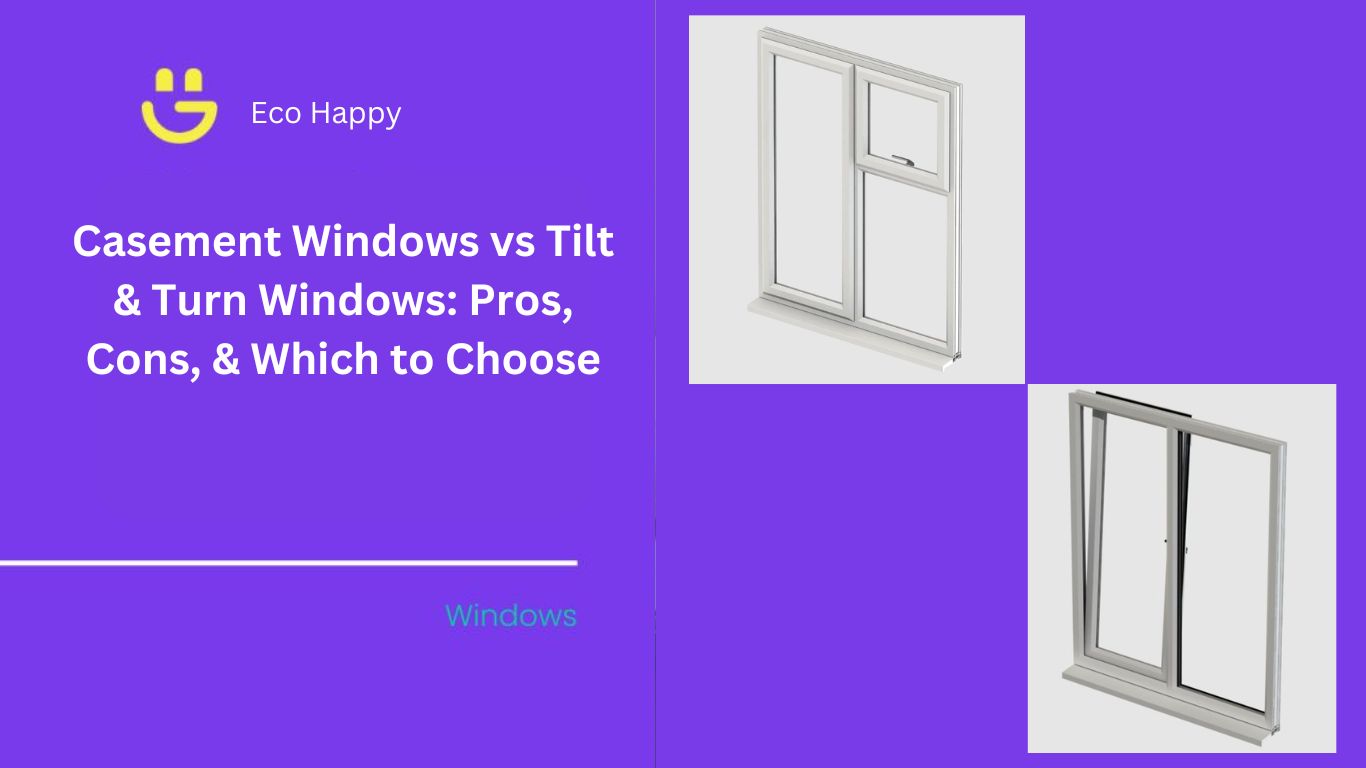Last Updated on March 17, 2025
Casement Windows vs Tilt and Turn Windows: Which Is Better?
When it comes to selecting the perfect windows for your home or property, the choice between casement windows and tilt and turn windows can be a tricky one.
Each has its own unique benefits, and the best choice will depend on factors like aesthetics, functionality, energy efficiency, security, and the type of property you’re working with.
In this comprehensive guide, we’ll compare casement windows and tilt and turn windows in detail, helping UK homeowners, landlords, and commercial property owners make an informed decision.
Contents
- 1 Casement Windows vs Tilt and Turn Windows: Which Is Better?
- 1.1 Casement Windows vs Tilt and Turn Windows: A Quick Comparison
- 1.2 Casement Windows vs Tilt and Turn: Key Differences
- 1.2.1 How Casement Windows Work
- 1.2.2 How Tilt and Turn Windows Work
- 1.2.3 Which Property Types Are Best for Casement Windows vs Tilt and Turn Windows?
- 1.2.4 Casement Windows vs Tilt and Turn Windows Materials
- 1.2.5 View & Natural Light Intake
- 1.2.6 Insulation & Energy Efficiency
- 1.2.7 Ventilation & Draughts
- 1.2.8 Security Features
- 1.2.9 Maintenance & Longevity
- 1.2.10 Costs & Installation
- 1.2.11 Installation Requirements & Timeframe
- 1.3 Which Is Best for Your Home: Casement Windows vs Tilt and Turn Windows?
- 1.4 Request a Free Quote for New Casement Windows vs Tilt and Turn Windows
- 1.5 FAQs
Casement Windows vs Tilt and Turn Windows: A Quick Comparison
| Feature | Casement Windows | Tilt and Turn Windows |
|---|---|---|
| Aesthetic Appeal | Traditional, classic look | Modern, versatile, sleek design |
| Opening Mechanism | Hinged at the side, swings outward | Can tilt inward or swing open fully |
| Ventilation | Provides excellent ventilation when open | Allows precise control of ventilation |
| Energy Efficiency | Highly energy-efficient with the right glazing | Also energy-efficient, especially with tilt function |
| Security | Secure with multi-point locking systems | Very secure, especially in the tilt position |
| Cost | Generally less expensive than tilt and turn | More expensive due to complex mechanisms |
| Best Suited For | Traditional, period-style properties | Modern homes, homes with limited space |
Casement Windows vs Tilt and Turn: Key Differences
Both casement windows and tilt and turn windows are fantastic options for homeowners in the UK, but which one is best for you depends on your priorities. Let’s take a deeper dive into each window type.
How Casement Windows Work
Casement windows are hinged at the side, allowing them to swing open like a door. This makes them ideal for providing full ventilation, as they open fully outward. They’re often seen in traditional and period-style homes due to their classic appearance.
These windows can be locked securely with a multi-point locking system, offering peace of mind for homeowners.
Key Features of Casement Windows:
Pros and Cons of Awning Windows
| Pros |
| Cons |
How Tilt and Turn Windows Work
Tilt and turn windows offer a dual-opening mechanism. They can be tilted inward from the top, allowing for controlled ventilation, or swung open fully from the side for maximum airflow. The design is more modern, and the window is highly secure when in the tilt position.
This type of window is popular for homes that need flexibility and functionality.
Key Features of Tilt and Turn Windows:
Pros and Cons of Tilt and Turn Windows
| Pros |
| Cons |
Which Property Types Are Best for Casement Windows vs Tilt and Turn Windows?
Best Properties for Casement Windows
Casement windows are ideal for traditional and period-style properties. They complement the classic design of older homes, particularly in the UK. If your property has a rustic or traditional aesthetic, casement windows are a great choice.
Best Properties for Tilt and Turn Windows
Tilt and turn windows are best suited for modern homes or properties where space might be limited. Their sleek, modern design fits well with contemporary properties and apartments, where practicality and security are key.
Casement Windows vs Tilt and Turn Windows Materials
Casement and tilt and turn windows come in a variety of materials. Each material offers different benefits depending on your needs.
Materials for Casement Windows:
- uPVC: Affordable, energy-efficient, and low maintenance
- Timber: Aesthetic and traditional, though requires more maintenance
- Aluminium: Strong and durable, though more expensive
Materials for Tilt and Turn Windows:
- uPVC: Highly energy-efficient and durable
- Timber: High-quality but may require more upkeep
- Aluminium: Provides a modern look and longevity
View & Natural Light Intake
Both casement and tilt and turn windows allow for a great deal of natural light to enter a room. However, casement windows tend to have fewer obstructions and provide a clearer, more expansive view when fully open.
Tilt and turn windows, while offering controlled ventilation, may not offer as wide an opening as casement windows.
Insulation & Energy Efficiency
Both types of windows can be highly energy-efficient, depending on the glazing options you choose. Double glazing and Low-E coatings can help keep your home warm in the winter and cool in the summer, improving insulation and reducing energy bills.
Glazing Options
| Glazing Type | Description | Best For |
|---|---|---|
| Double Glazing | Two panes of glass with a gap in between | Basic insulation and noise reduction |
| Triple Glazing | Three panes of glass for maximum insulation | Homes in cold climates or noise-sensitive areas |
| Low-E Glass | Glass with a special coating to reflect heat | Improving energy efficiency |
Double glazing and triple glazing options are available for both casement and tilt and turn windows. Triple glazing offers the best insulation, while double glazing remains the most common choice for UK homeowners.
Ventilation & Draughts
Casement windows provide excellent ventilation, particularly when fully opened. Tilt and turn windows also offer great ventilation, especially in the tilt position, which lets in a controlled amount of fresh air.
However, tilt and turn windows may be better at preventing draughts due to their more secure sealing mechanisms.
Security Features
Both window types are equipped with strong multi-point locking systems for enhanced security. Tilt and turn windows, however, have an additional security advantage when in the tilt position, as it limits access to the interior of your home.
Maintenance & Longevity
Both window types require minimal maintenance, especially if they’re made from uPVC or aluminium. However, timber windows require more upkeep to prevent rot and damage from the elements.
| Maintenance Aspect | Casement Windows | Tilt and Turn Windows |
|---|---|---|
| Cleaning | Requires external cleaning for upper windows | Easier to clean from inside |
| Wear and Tear | Long-lasting if maintained | Long-lasting, but more complex mechanism |
| Longevity | Typically 20-30 years | Typically 25-40 years |
Costs & Installation
Casement window costs are generally less expensive than tilt and turn windows due to their simpler design. However, the higher costs of tilt and turn windows can be justified because they offer more functionality and security.
| Window Type | uPVC | Timber | Aluminium |
|---|---|---|---|
| Casement | £300-£400 | £500-£700 | £800-£1,200 |
| Tilt and Turn | £400-£600 | £600-£900 | £1,000-£1,500 |
Installation Requirements & Timeframe
Installation for casement windows is generally quicker and less expensive due to the simpler mechanism. Tilt and turn windows, due to their more complex design, can take longer to install and may require more specialized labor.
Which Is Best for Your Home: Casement Windows vs Tilt and Turn Windows?
The best window type for your property depends on several factors, including the cost of the new windows, aesthetic preferences, and functionality. If you’re looking for a traditional design with excellent ventilation and security, casement windows are a great choice.
However, if you want a more modern, secure, and versatile window with easy cleaning and space-saving benefits, tilt and turn windows may be your ideal option.
Related Window Comparisons
When choosing between casement windows and tilt and turn windows, it’s also worth considering how other window types compare. Each style has unique benefits depending on your home’s design, ventilation needs, and functionality preferences.
Request a Free Quote for New Casement Windows vs Tilt and Turn Windows
Choosing between casement windows and tilt and turn windows can be a big decision, but with expert guidance, you can make the right choice for your home.
Request a free quote today to get started on your window installation journey and enjoy the benefits of energy efficiency, security, and style in your home!
FAQs
Are casement windows cheaper than tilt and turn?
Yes, casement windows are generally cheaper than tilt and turn windows. This is because casement windows have a simpler hinge mechanism and fewer moving parts, making them more cost-effective to manufacture and install.
Tilt and turn windows, on the other hand, have a more complex design that allows them to open in multiple ways, which can increase production and installation costs. However, the final price will depend on factors such as materials, glazing options, and customization.
Do tilt and turn windows leak?
No, tilt and turn windows are designed to provide excellent weather resistance and are unlikely to leak when properly installed. Their airtight sealing system and multi-point locking mechanism create a tight seal that prevents drafts and water infiltration.
However, poor installation or lack of maintenance can compromise their performance, leading to potential leaks over time.
How long do tilt and turn windows last?
Tilt and turn windows are built to last and can typically have a lifespan of 30 to 50 years, depending on the materials used and how well they are maintained. High-quality uPVC, aluminum, and timber tilt and turn windows can provide decades of durability with regular cleaning and upkeep.
Proper maintenance, such as lubricating the hinges and ensuring seals remain intact, can extend their longevity.
Are casement windows the most efficient?
Casement windows are among the most energy-efficient window types. Their design allows for a tight seal against the frame when closed, minimizing air leakage and improving thermal efficiency.
They are particularly effective when equipped with double or triple glazing. However, tilt and turn windows also offer excellent energy efficiency due to their airtight seals and ability to provide controlled ventilation.
The efficiency of both window types will depend on factors such as glazing, frame material, and installation quality.






James Elston
Boiler Expert
James Elston is the top boiler replacement and heating expert at Eco Happy. He has over 20 years of experience in the industry, focusing on Gas Safe boiler installations and offering home-heating and energy-saving solutions to homeowners across the UK. From sourcing the most energy-efficient combi boiler to providing specialist heating advice, James ensures that Eco Happy maintains the highest standards and best customer service.